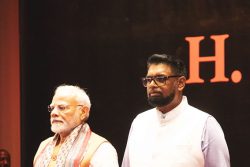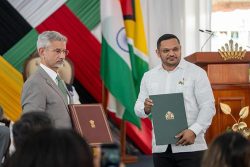Dear Editor,
Reference is made to Keith Bernard’s letter of September 5, 2024, published in Stabroek News, where he calls for a reconsideration of how Guyana is governed. This topic is indeed timely but the author lacks an in-depth understanding of other governance models. For example, he mentions the Swiss system of direct democracy but then dismisses it as difficult to adopt. As a Guyanese born and largely raised in Switzerland, I have ample experience with Swiss democracy and how the Swiss Federal State is organized, and strongly believe that it can serve as an excellent case study for Guyana! Keith Bernard writes that scaling up the Swiss model is tricky, but this is not the issue here. The population of Switzerland has reached 9 million people, which is more than ten times larger than that of Guyana.
Switzerland is comprised of 26 cantons (equivalent to the states in the US), which enjoy far-reaching autonomy including the right to raise communal and cantonal taxes. The Federal Government is organized largely along the principles defined in the Constitution of the United States, which was the only example available to the Swiss in 1848, when they crafted the Constitution of the Swiss Federal State. Importantly, the Swiss adapted the US constitution to accommodate the specific requirements of the Swiss people, who were not accustomed to a strong central state led by a monarch. This explains why the Swiss president is comparatively weak and does not have the same executive powers that a US (or Guyanese) president enjoys.
The power is concentrated with the legislature, which is a two-chamber parliament. The Swiss Federal Parliament is composed of a National Council elected on the basis of proportional representation, and the Council of States (equivalent to the US Senate), which represents the cantons. Both chambers of the Federal Parliament enjoy equal power and laws have to be passed by both chambers with a majority. In addition, each law approved by parliament can be challenged by the public in a referendum. To do so, 50,000 signatures have to be collected, which then will trigger a national vote on the new law. Hence, the Swiss people have the ultimate say on any new legislation. This may sound cumbersome and risky, but this mechanism of direct democracy has moderating effects on the Federal Parliament. It aims at crafting legislation that reflects the majority opinions of the Swiss population. If it fails to do so, it runs the risk of having new legislation rejected at the ballot box. As a consequence, Switzerland has become a very stable democracy as it is grounded in consensus building and compromise finding.
Being fully aware of the deep divisions that run through Guyanese politics, I am of the strong belief that adopting elements of Swiss direct democracy could offer a unique opportunity to overcome these divisions. For example, the tool of a referendum on laws passed by parliament would force the dominant political forces in Guyana to workout solutions to the pressing problems of the nation that serve not only the base and constituents of the party in power but the broad population independent of political preference and ethnic loyalties. Furthermore, the introduction of a two-chamber parliament would have advantages as it would allow for direct representation of the regions and their specific interests in parliament and would subject the legislative process to greater scrutiny and checks.
The key question however is how can real and deep constitutional change be achieved? Unfortunately, no party in power will agree to changes of the current political system, which serves them so well. This is best evidenced by what happened in 1992, when PPP took power after years in opposition. In 1980, Guyana’s president Linden Forbes Burnham dumped the traditional Westminster system, in place since independence in 1966, in favour of an authoritarian constitution with a strong presidency. This constitutional change was strongly opposed by the PPP, while in opposition. However, once the PPP gained power, Cheddi Jagan failed to reject the Burnham constitution in favour of crafting a more democratic constitution for Guyana.
In Switzerland, the transition from a loose confederation of independent cantons to a federal state with semi-autonomous cantons was only possible after a brief civil war in 1847, which was won by the liberal and radical forces over the conservatives. This laid the basis for the visionary Swiss constitution of 1848. The transition to a federal state with a stable and accountable federal government and the rule of law was also key to Switzerland’s economic rise starting in the 19th century to become one of the most prosperous nations on the planet, without any natural resources except for its hard-working population. Is Guyana ready to undergo serious and fundamental constitutional reform without a major political crisis?
Sincerely,
Andre Brandli, PhD
Professor, LMU Munich, Germany




